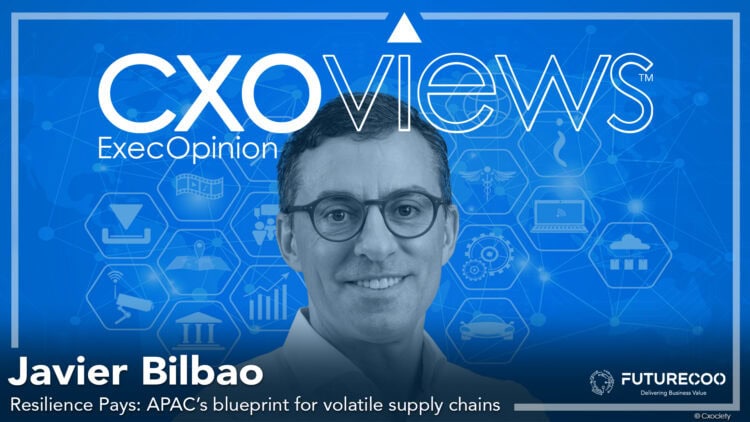As chief operating officers (COOs) across Asia navigate an era defined by relentless volatility, the imperative to build agile, intelligent, and sustainable supply chains has never been greater.
From geopolitical tensions and climate-related disruptions to evolving trade policies and digital transformation, Southeast Asia stands at the heart of both the challenges and opportunities shaping global supply chain strategy in 2025 and 2026.
With intra-regional trade deepening and digital infrastructure advancing rapidly, the region is emerging as a critical hub for resilient supply chain networks. The DHL Global Connectedness Report 2024 estimates that around 70% of APAC countries already have strong intra-regional trade connections, laying the foundation for a more self-reliant and responsive economic bloc.
For COOs, this shift presents a strategic opportunity to recalibrate sourcing, logistics, and risk management frameworks with regional dynamics at the core.
Geopolitical risk and the rise of regionalisation
Geopolitical instability continues to disrupt global trade flows, prompting enterprises to re-evaluate long-standing dependencies. In response, supply chain diversification has become a cornerstone of resilience planning. Javier Bilbao, CEO of DHL Supply Chain APAC, underscores this shift:

“While supply chains will inevitably evolve, we see resiliency will always be the name of the game. At DHL Supply Chain, we have found that having a diverse network of suppliers and logistics hubs across different regions significantly helps when geopolitical disruptions occur, such as trade conflicts or sudden regulatory changes.” Javier Bilbao
This strategic diversification is backed by substantial investment. DHL’s €350 million commitment to Southeast Asia and €500 million in India reflect a broader trend of companies strengthening regional infrastructure, automation, and talent development to support multi-shoring and omni-sourcing models.
These approaches allow firms to spread risk without incurring prohibitive cost increases, particularly as nations like Vietnam, Indonesia, Thailand, and Malaysia offer competitive operating environments and growing logistical connectivity.
For COOs, the challenge lies in striking a balance between complexity and control. As Bilbao notes, “diversification isn’t without trade-offs.”
Managing multiple suppliers across jurisdictions introduces regulatory, logistical, and coordination challenges. Yet, he argues, “reliable logistics partners with regional experience and solid infrastructure become crucial in managing these complexities.”
Balancing resilience and cost
Historically, cost optimisation dominated supply chain decision-making. However, in 2025–2026, resilience has ascended as a primary KPI. While cost remains important, COOs are increasingly justifying investments in redundancy, nearshoring, and digital visibility as essential insurance against disruption.
According to Bilbao, DHL has mastered regional integration that enables resilience without sacrificing efficiency.
“Many companies are taking advantage of these regional ties by exploring opportunities in markets such as Indonesia, Vietnam, Philippines, Thailand and Malaysia. These countries offer competitive costs, helping businesses spread their supply chain risks without necessarily increasing expenses.” Javier Bilbao
The integration of digital twin simulation and predictive analytics further enhances this balance. By modelling potential disruptions—from port congestion to tariff changes—COOs can stress-test supply chain configurations and make data-driven decisions. DHL supports this with tools that help “navigate local regulations, manage logistics challenges, and keep unexpected costs under control.”
Ultimately, as Bilbao observes, resilience investments must deliver tangible value: “tapping into local market insights and proven logistics expertise ensures that investment in resilience brings real, measurable value: shorter lead times, stable costs and happier customers.”
Visibility as a competitive advantage
In a market characterised by persistent uncertainty, visibility is critical. The adage, what you don’t know can’t hurt you,” when applied in the supply chain, can spell the end of an organisation. This was the case of Hershey in 1999 when it lost US$150 million in orders due to a lack of visibility in its order management system.
“Real-time tracking tools, such as IoT devices and GPS systems, allow us to closely monitor the location and condition of goods across the entire supply chain,” says Bilbao. “This helps us proactively address issues, such as delays or damage, making decisions faster and minimising disruptions.”
Digital technologies are no longer optional—they are central to operational agility. In 2025, leading enterprises are leveraging robotics, real-time tracking, and AI-driven analytics to achieve unprecedented levels of visibility and efficiency.
DHL’s approach to tool integration
“We have found that using robotics, data-driven analytics, and tracking systems helps us to manage inventory better, reduce operational errors, and deliver quicker, more reliable service,” asserts Bilbao.
In warehouses, automated guided vehicles and robotic picking systems work alongside human teams, reducing errors and accelerating fulfilment. Meanwhile, IoT sensors and GPS tracking enable end-to-end shipment monitoring, allowing proactive intervention in cases of delay or damage.
To ensure return on investment, DHL employs three proven strategies:
- Integration with existing processes: Technology is seamlessly integrated into daily workflows, rather than operating in silos.
- Customer-focused tools: Platforms like MySupplyChain offer near real-time visibility, empowering customers to respond swiftly to disruptions.
- Continuous evaluation and improvement: Performance metrics such as order fulfilment times and inventory accuracy are regularly reviewed to maintain relevance and impact.
For COOs, the lesson is clear: digital transformation must be purpose-led, integrated, and continuously refined to deliver sustained value.
From compliance to competitive edge
Environmental, social, and governance (ESG) regulations are tightening across Asia, compelling COOs to embed sustainability into core operations. The focus is shifting from compliance to innovation, where green initiatives also drive efficiency and brand equity.
Bilbao identifies transportation and warehousing as key levers for decarbonisation:
“One effective step is transitioning to low-carbon transportation. DHL Supply Chain’s global Green Transport Policy, for instance, aims to reduce approximately 300,000 metric tons of greenhouse gas emissions from 2,200 trucks by adopting electric or hydrogen-powered vehicles, hydrotreated vegetable oil, and biogas.”
By 2026, DHL plans to invest an additional €200 million in fossil fuel alternatives, advancing its parent group’s goal of electrifying two-thirds of its pickup and delivery fleet by 2030. Simultaneously, the company is committed to achieving net-zero operational carbon emissions in all owned warehouses by 2025.
Collaborative innovation is amplifying these efforts. In Japan, DHL’s Sagamihara Logistics Centre achieved carbon-neutral operations through a unique agrivoltaic project—installing over 1,000 solar panels above farmland.
In the Philippines, a 120-kWp solar rooftop installation powers a training facility. Such partnerships demonstrate how sustainability can be both scalable and synergistic.
Additionally, circular packaging solutions—such as reusable temperature-controlled containers and AI-optimised carton sizing via OptiCarton—are reducing waste and emissions while cutting costs.
The human and digital frontlines
As supply chains grow more digital, the war for talent intensifies. Bilbao acknowledges that “talent shortage is a challenge, especially with new technologies rapidly changing how logistics works.”
The modern logistics role demands digital fluency, adaptability, and problem-solving skills—attributes increasingly scarce in the current workforce.
To address this, DHL focuses on tailored training, continuous learning, and fostering a culture of innovation. Crucially, the company aligns its employer value proposition with the expectations of younger generations: flexibility, purpose, and growth opportunities.
“We strive to be recognised as an Employer of Choice and a Great Company to Work for All… Can they see the value and impact of their work, and does it serve a bigger purpose? And importantly, are there meaningful opportunities for them to grow personally and professionally?” Javier Bilbao
The cybersecurity angle
Equally critical is cybersecurity. With supply chains increasingly reliant on operational technology (OT)—sensors, automation, and IoT devices—the attack surface has expanded.
To enhance cybersecurity, Bilbao recommends implementing robust authentication, encryption, and regular security updates for critical infrastructure like SCADA systems used in energy management and manufacturing.
He also suggests separating IT networks from OT networks helps prevent breaches in one from affecting the other, achieved through firewalls, VLANs, and dedicated communication channels monitored in real-time.
“We also emphasise securing IoT devices, such as sensors and smart trackers, by requiring strong authentication and regular firmware updates," says Bilbao. "Mobile and edge devices, which are increasingly used in supply chains, need encryption and remote management for added protection."
He suggests using technologies like Security Information and Event Management (SIEM) systems to continuously monitor OT devices and respond promptly to potential threat.
For COOs, securing the extended supply chain ecosystem—especially second- and third-tier suppliers—is no longer optional but a core operational responsibility.
Leading through uncertainty
In 2025 and 2026, COOs in Asia must lead with foresight, collaboration, and technological fluency. Wassim Mnif, COO, Asia Pacific, DHL Supply Chain observes that regional trade agreements, such as the Regional Economic Partnership(RCEP) are becoming increasingly important as they directly impact sourcing, distribution, and operational strategies.
He posits that with frequent shifts in tariffs and trade policies, businesses must constantly recalibrate their supply chains to stay compliant, minimize costs, and avoid delays.

"Regional trade agreements significantly simplify these challenges by lowering trade barriers, streamlining customs processes, and enhancing supply chain connectivity across Asia Pacific." Wassim Mnif
"This means easier cross-border logistics, reduced operational complexity, and greater cost efficiencies, ultimately helping businesses manage volatility effectively," concludes Mnif.
Anticipate, adapt and thrive
Recent geopolitical events have exposed vulnerabilities in supply chains, leading companies to diversify sourcing strategies and increase port capacities to mitigate future risks.
As COO in Asia, it’s crucial to emphasize that businesses today must not just react to disruptions but proactively prepare for uncertainties. Bilbao highlights that "using predictive modelling and advanced analytics has proven particularly effective."
AI-driven tools enhance an organisation’s ability to forecast demand accurately, manage inventory, and identify alternative logistics routes swiftly.
"Using advanced analytics to achieve real-time supply chain visibility helps businesses to quickly adapt to changing circumstances, ensuring their supply chains remain agile and reliable," asserts Bilbao.
Resilience is no longer about bouncing back—it is about anticipating, adapting, and thriving in the face of perpetual change. For those who invest wisely in people, partnerships, and innovation, Southeast Asia’s volatility may well become its most significant advantage.



